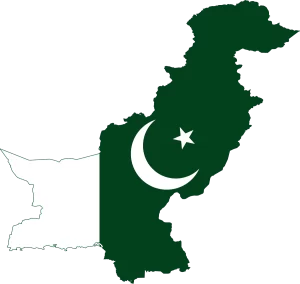Geographical position and Climate of Pakistan
Pakistan is located in South Asia, bordered by India to the east, Afghanistan and Iran to the west, China to the north, and the Arabian Sea to the south. It lies roughly between latitudes 24° and 37° N, and longitudes 61° and 77° E. The country’s geography varies greatly from the coastal areas of the south to the mountains of the north, which include some parts of the Himalayas, the Karakoram, and the Hindu Kush ranges.
The climate of Pakistan is characterized by distinct variations across its different regions:
- Northern Areas: The mountainous regions of the north, including Gilgit-Baltistan and Azad Kashmir, experience alpine climates with long, cold winters and short, cool summers. Heavy snowfall is common in winter.
- Plains: The vast plains of Punjab and Sindh have an arid to semi-arid climate, with hot summers where temperatures can exceed 40°C (104°F), and relatively mild winters.
- Coastal Areas: Along the southern coast, including Karachi, the climate is typically arid with mild winters and hot summers, moderated by the proximity to the Arabian Sea.
- Western Regions: Balochistan’s highlands have a desert climate with extremely cold winters and hot summers, while the lower-lying areas are arid and warm.
Monsoon rains primarily affect the eastern regions from July to September, contributing significantly to the annual rainfall. However, some northern and western areas receive rainfall predominantly from the western disturbance during the winter months.
Brief history of Pakistan
The region that is now Pakistan has been the cradle of civilizations for millennia, with a history that begins with ancient cultures such as the Indus Valley Civilization, which flourished around 2500 BCE.
Colonial Era: Fast forward to the modern era, the area became a part of the British Indian Empire in the 19th century. During this time, the struggle for independence grew, and the concept of a separate nation for Muslims of the Indian subcontinent began to take shape, led by the All-India Muslim League under the leadership of Muhammad Ali Jinnah.
Partition and Independence: Following World War II, the movement for a separate Muslim state intensified, culminating in the partition of British India in 1947. This led to the creation of the Dominion of Pakistan on August 14, 1947, comprising two geographically and culturally separate areas, West Pakistan (present-day Pakistan) and East Pakistan (now Bangladesh).
Early Challenges: The young nation faced numerous challenges including mass migrations, disputes over territories, particularly the princely state of Kashmir, and the establishment of a new government and constitution.
Bangladesh Independence: Political and economic disparities between the two wings of Pakistan led to civil unrest and eventually a bloody conflict, resulting in the secession of East Pakistan and the formation of the independent nation of Bangladesh in 1971.
Modern Pakistan: Since its independence, Pakistan has oscillated between military and civilian rule, with periods of martial law. It has played a significant role in regional politics, particularly in relation to its neighbors India and Afghanistan. The country has also been pivotal in strategic geopolitical affairs, especially during the Cold War and the war on terror.
Today, Pakistan is the world’s fifth-most populous country and continues to face various challenges including political instability, economic issues, and regional security concerns while striving for development and progress.
Religion
The predominant religion in Pakistan is Islam, with the vast majority of the population being Muslims. According to the constitution, Pakistan is an Islamic republic, and Islam is the state religion. Religious freedom is constitutionally guaranteed in Pakistan, but in practice, minorities often face discrimination and sometimes violence. The country’s blasphemy laws have been a subject of international concern, as they have been used to target religious minorities as well as Muslims accused of deviating from orthodox beliefs.
Language
The official language of Pakistan is Urdu, which serves as the lingua franca and is widely used in education, media, and for official purposes. English is also recognized as an official language and is used extensively in government, legal affairs, and business. Other regional languages include Sindhi, Pashto, Balochi, Saraiki, and many others, reflecting the country’s rich linguistic diversity.

